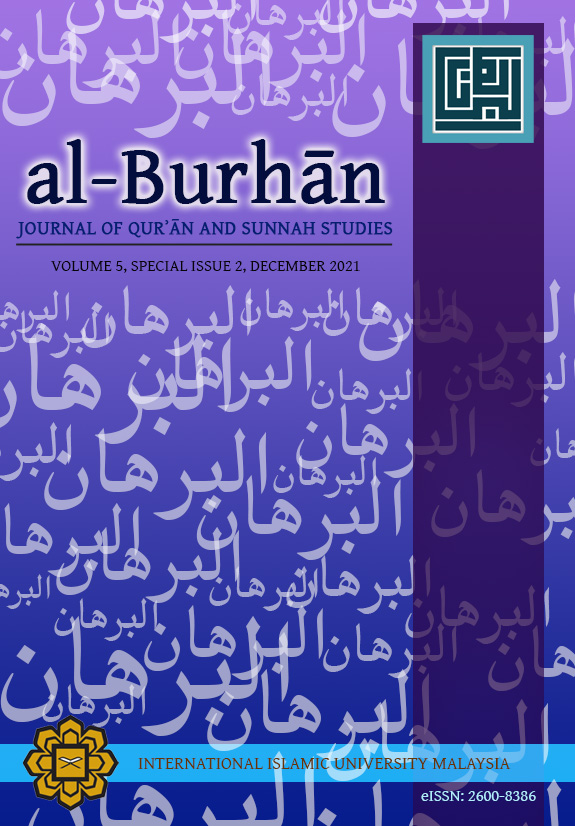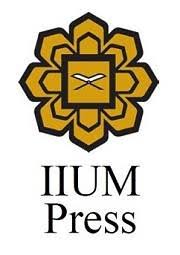حديث رؤية الهلال بين الإشكالية والحل
The Ḥadīth on Moonsighting: Problem and Solution
DOI:
https://doi.org/10.31436/alburhn.v5iSpecial%20Issue%202.243Keywords:
mushkil al-ḥadīth, moonsighting, ḥadīth studies, fasting Ramadan, falak calculationAbstract
This research deals with the problem of the famous ḥadīth “Observe fast upon sighting it (the new moon), and break your upon sighting it” in determining the beginning of the lunar month and discusses its solution taking into consideration the temporal dimension of the rulings derived from the ḥadīth. It discusses the verses and ḥadīths related to the significance of this topic in the light of their commentaries. It attempts to analyse the evidences depended upon by prominent scholars who argue in favour of visual sighting and opposing views of scholars who permit the utilisation of contemporary astronomical calculations. The research concludes that the Qur’an and ḥadīth neither clearly indicate that visual sighting is the legal requirement to establish the beginning of the lunar month, nor present it as the only inevitable means of proof. The desired objective of the ḥadīth is fasting the whole of Ramaḍān without missing any days of it. Visual sighting was the means for people during the time of the Prophet, as indicated by the ḥadīth: “We are a nation that neither write nor calculate.” There is nothing wrong with changing means due to advancements, taking into consideration the temporal and spatial dimensions of the ḥadīth, just as we rely on the compass in determining the direction of the qiblah and the specific time of prayer, especially in an era when man was able to ascend and land on the moon - as claimed -. God does not burden a soul beyond its capacity; and God wants ease not hardship for the ummah.
Downloads
References
Abū Rakhiyyah, Mājid. Ithbāt Hilāl Ramaḍān Bayna al-Ruʾyah al-Baṣariyyah Wa al-Ḥisābāt al-Falakiyyah. Amman: Maktabah al-Aqṣā, 1990.
al-Bukhārī, Muḥammad ibn Ismāʿīl Abū ʿAbd Allah. al-Jāmiʿ al-Musnad al-Ṣaḥīḥ al-Mukhtaṣar Min Umūr Rasul Allah Wa Sunanihi Wa Ayyāmihi. Edited by Muhammad Zuhair al-Nasir. Beirut: Dār Ṭawq al-Najāh, 2001.
al-Ghumārī, Aḥmad ibn Muḥammad ibn al-Ṣiddīq. Tawjīh al-Anẓār Li-Tawḥīd al-Muslimīn Fī al-Ṣawm Wa al-Ifṭār. Amman: Dār al-Bayāriq, 1999.
al-Jawharī, Ismāʿīl ibn Ḥammād Abū Naṣr al-Fārābī. al-Ṣiḥāḥ Tāj al-Lughah Wa Ṣiḥāh al-ʿArabiyyah. Beirut: Dār al-ʿIlm li al-Malāyīn, 1987.
al-Jazāʾirī, Muḥammad ibn ʿAbd al-Karīm. al-Ḥukm al-Sharʿ Li-Ruʾyat al-Hilāl Bi al-Abṣār Wa Ibṭāl Naẓariyyat al-Ḥisāb al-Falakī Fī al-Ṣawm Wa al-Ifṭār. Dār wa Maktabah al-Maʿārif, 2012.
al-Khayrʾābādī, Mohammed Abullais. ʿUlūm al-Ḥadīth Aṣīluhā Wa Muʿāṣiruhā. Kuala Lumpur: Dār Shākir, 2009.
al-Nawawī, Yaḥyā ibn Sharaf Abū Zakariyyā. al-Minhāj Sharḥ Ṣaḥīḥ Muslim Ibn al-Ḥajjāj. Beirut: Dār Iḥyāʾ al-Turāth al-ʿArabī, 1972.
al-Qaraḍāwī, Yūsuf. Kayfa Nataʿāmal Maʿa al-Sunnah al-Nabawiyyah. Herndon: International Institute of Islamic Thought, 1992.
al-Rāzī, Muḥammad ibn ʿUmar Abū ʿAbd Allāh Fakhr al-Dīn. Mafātīḥ al-Ghayb. Beirut: Dār al-Fikr, 1981.
al-Subkī, ʿAbd al-Wahhāb ibn ʿAlī Tāj al-Dīn. Fatāwā al-Subkī. Beirut: Dār al-Maʿrifah, n.d.
Ali Shah, Zulfiqar. al-Ḥisābāt al-Falakiyyah Wa Ithbāt Shahr Ramaḍān: Ruʾyah Maqāṣidiyyah Fiqhiyyah. Herndon: International Institute of Islamic Thought, 2009.
Ibn Ḥajar al-ʿAsqalānī, Aḥmad ibn Muḥammad ibn ʿAlī. Fatḥ al-Bārī Sharḥ Ṣaḥīḥ al-Bukhārī. Riyadh: Dār al-Salām, 2000.
Ibn Manẓūr, Jamāl al-Dīn Muḥammad. Lisān al-ʿArab. Beirut: Dār Ṣādir, n.d.
Muslim, Ibn al-Ḥajjāj al-Naysābūrī. al-Musnad al-Ṣaḥīḥ al-Mukhtaṣar Min al-Sunan Bi Naql al-ʿAdl ʿan al-ʿAdl Ilā Rasul Allah. Cairo: Dār al-Taʾṣīl, 2014.
Downloads
Published
How to Cite
Issue
Section
License
In general, reusing or reproducing substantial portions of al-Burhān content requires permission. This includes the use of text, figures, tables, multimedia content, and any other material published in any issues of al-Burhān Journal of Qur'an and Sunnah Studies. For some instances, al-Burhān may make its content freely viewable; however, such material may require permission for reuse. To seek permission, please contact the editorial.









